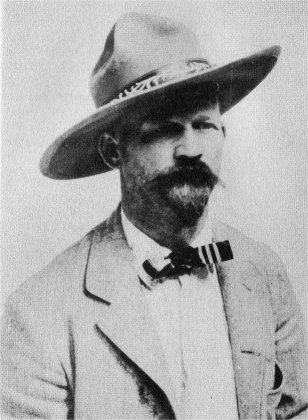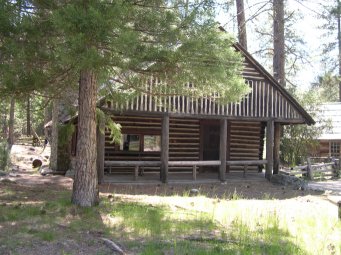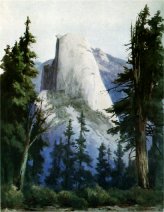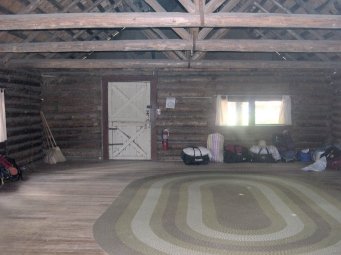 |
| CHRIS JORGENSEN |
Chris Jorgensen was born in Oslo, Norway, in 1860. At the age of ten years he came to America making California his home. He was interested in drawing and painting from earliest childhood and was the first student to enroll in the California School of Fine Arts organized in San Francisco in 1874. From 1881 to 1883 he was assistant director of the school. In his sketch class was Angela Ghirardelli, a young society girl of San Francisco, a gifted
pupil and art critic. Jorgensen’s picture, “Along the Wharfs,” had hung on the wall of the school for some time. Angela admired it and appraised it highly. It was exhibited by the Art School in 1882 and immediately sold. Angela felt the loss of the picture so keenly that Jorgensen recovered it from the purchaser and presented it to his pupil. The following year Chris Jorgensen and Angela Ghirardelli were married. There followed more than half a century of rare companionship. Two children, a son and daughter, completed the family circle.
In 1892 Mr. and Mrs. Jorgensen went to Italy, the homeland of Angela Ghirardelli, where they spent two years with Italy’s great artists. Shortly after returning Jorgensen built a studio home in Yosemite, for which he drew the plan and did much of the labor of building. The panel over the fire-place—a study of heads—was the work of Mrs. Jorgensen. The artist made all the furniture in this studio home. Mr. Jorgensen says of this home: “The studio proper is a room twenty-four feet square and is always open during the summer for friend or stranger. The big, broad porch of our cottage—ten feet in width—is a main lounging place and it is here that most of the social life goes on.” This studio he used for twenty years. It was here that he began his painting of Yosemite scenes, most of which canvases were sold from the studio. Among these were “Yosemite in the Winter,” “Cathedral Spires,”and “Happy Isles.” Other noted pictures of this period are“Mount Lyell at Sunset,” “Big Trees,” and the entire “Yosemite Valley,”the canvas needed for this painting was so large that it was taken to the point of view on a truck and here the artist did his work.
Chris Jorgensen had a deep feeling for the old missions which he expressed on canvases. When in 1905 he built a studio home at Carmel-by-the-Sea he painted the Carmel Mission for the panel above the fire-place. He also built a bungalow at Pebble Beach. His home on the Piedmont Hills, surrounded by trees and shrubs and winding ways, was an artist’s home built for the family; for artist friends; for the social life of the son and daughter
and their friends; it was built to meet the unlimited hospitality which characterized both Mr. and Mrs. Jorgensen. It was a rambling house of many rooms in each of which a picture from nature in its changing moods was framed in.
Chris Jorgensen had a studio home in his beloved San Francisco where he was also a member of the Bohemian Club and where his pictures were frequently exhibited. His canvases are many and will live for their portrayal of mountain grandeur; of boisterous waters; of quiet meadows; of by-gone mission days; of fishermen and wharves. One great picture will live in history. This canvas is the expression of the artist’s love and distress for the city that fell in April, 1906. It bears the title “San Francisco in Ruins.”
In Galen Clark’s book,
Yosemite Indians,published in 1904, are four drawings by Chris Jorgensen. The cover design and the drawing of a “Chuck'-ah” are by Mrs. Jorgensen. Jorgensen’s portrait of Galen Clark, etched on a slab of red-wood, has, for many years hung in the Yosemite Museum and is much admired.
Chris Jorgensen died at his Piedmont studio after a brief illness on June 25, 1935. Only a few months later, in February, 1936, Mrs. Jorgensen died. The recaptured picture, “Along the Wharves,” was still hanging on the wall of her room, a precious token of girlhood days. The son, Virgil Jorgensen, is the only survivor, the daughter having died some years ago.
By the will of Mrs. Jorgensen many of her husband’s paintings are bequeathed to the United States Government for exhibit at the Yosemite Museum.
(http://www.yosemite.ca.us/library/yosemite_indians_and_other_sketches/early_artists.html#page_85)
Chris Jorgensen's Studio (c. 1903)
(...) Another artist closely associated with Yosemite was Norwegian-born
Chris Jorgensen (1860–1935), who contributed five illustrations to Galen Clark’s Indians of the Yosemite. In 1900, Jorgensen built a studio-home on the north bank of the Merced River in Yosemite Valley. Three years later, he added a log home, “the bungalow,” near Sentinel Bridge. It may have been this cabin that the San Francisco Call reported had been made available for the accommodation of President Theodore Roosevelt when he visited Yosemite in May, 1903.(...)
 |
| “The Bungalow” |
“The Bungalow”
Chris Jorgensen Artist
The era of the artist in Yosemite extends from 1855 to the present time. Artists were drawn to Yosemite, where they found inspiration in the magnificent scenery. Artist’ paintings, drawings, sketches, and photographs publicized and popularized Yosemite. They excited the curiosity of folks, and interest in the area grew rapidly. Consequently, many people chose to travel the rough route to Yosemite and experience the beauty firsthand.
Artists were among the first pioneers to enjoy and appreciate this area for the sake of its natural beauty and grandeur. Explorers, writers, and early tourist parties of the 1850’s returned from Yosemite with stories of spectacular beauty. It is they who brought to public attention the magnificence of 30-foot wide trees and 1,000-foot waterfalls, instilling a sense of wonder in those who had never seen the Yo-Semite.
Artist Chris Jorgensen, a noted painter, was one of many artists who popularized Yosemite and specialized in scenic paintings in oil and watercolor. Jorgensen first came to Yosemite Valley in 1898 and camped two summers before building his first cottage—a studio and residence—on the north bank of the Merced River in 1900. In 1903, he built a one-story, one-room log structure,“the bungalow,” on the opposite side of the river from the Sentinel Hotel in the Old Upper Village, and a short distance above the Sentinel Bridge. Jorgensen maintained a separate studio nearby, and also had a barn and storehouse. This new residence had a wood shingle-covered gable roof, with the front decorative gable end projecting ten feet beyond the front wall of the cabin. Its walls consisted of peeled logs in alternating tiers and contained an original stained glass window. Jorgensen maintained a seasonal residence and studio in the valley until 1918.
 |
Half Dome from Washburn
Point Area. Watercolor by
Christian Jorgensen
(Yosemite Museum)
|
In 1917 the National Park Service was established.After a summer of inadequate tent quarters for a government mess, the operation moved into the old Jorgensen cabin, which the artist had vacated after relinquishing his concession. A committee of three men appointed by Superintendent W. B. Lewis made the studio into a clubhouse for members of the mess by converting it into a kitchen and dining room.
In 1921 the Yosemite Museum was established and housed in the old Jorgensen cabin. This was the first museum in a National Park. Chris Jorgensen donated his extensive Native American basket collection to the newly-established Yosemite Museum in 1923. In 1926 a “permanent” museum was built in the new Yosemite Village, partly on donations from school children and others.
Chris Jorgensen died in 1935 and the Yosemite Museum acquired 198 oil and watercolor paintings from his heirs. These were on display until around 1966 when the Yosemite Museum was closed for use as administrative offices. Unfortunately, since the museum closure the public cannot view his art or other Museum collections.
In 1962 the Park Service razed the earlier Jorgensen studio and residence (built in 1900) and moved the latter bungalow (built in 1903) to the Yosemite Pioneer History Center, in the mistaken belief that it was the studio building. So, unfortunately, the latter Jorgensen home that was preserved instead of his studio. The Jorgensen Cabin is listed in the National Register of Historic Places (art, local).
(http://www.yosemite.ca.us/pioneer-yosemite-history-center/artist_home.html)
http://www.yosemite.ca.us/pioneer-yosemite-history-center/artist_home.html
http://www.yosemite.ca.us/library/yosemite_indians_and_other_sketches/early_artists.html#page_85
http://www.museumcollections.parks.ca.gov/code/emuseum.asp?emu_action=searchrequest&moduleid=2&profile=people¤trecord=1&searchdesc=Christian%20August%20J%C3%B6rgensen&style=single&rawsearch=constituentid/,/is/,/37/,/false/,/true






No hay comentarios:
Publicar un comentario